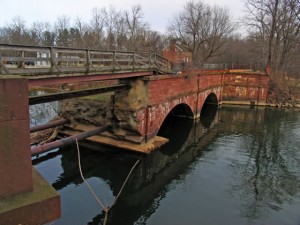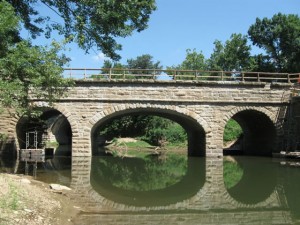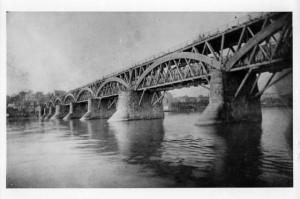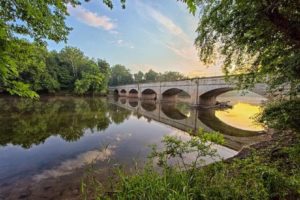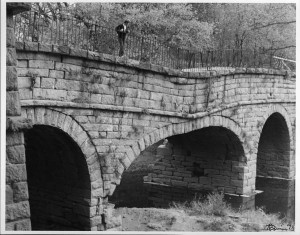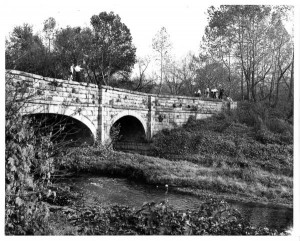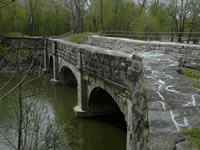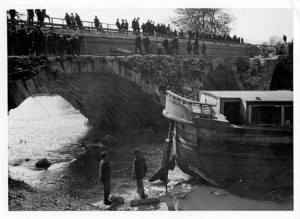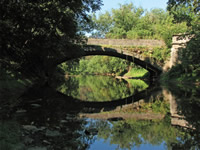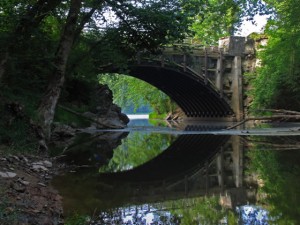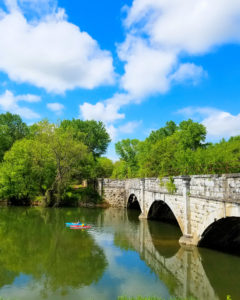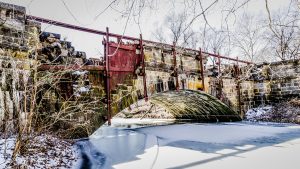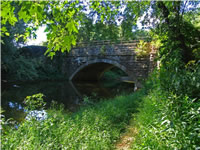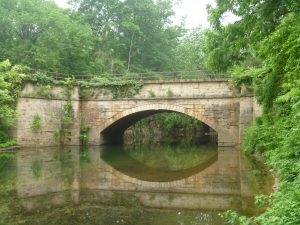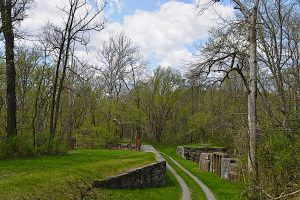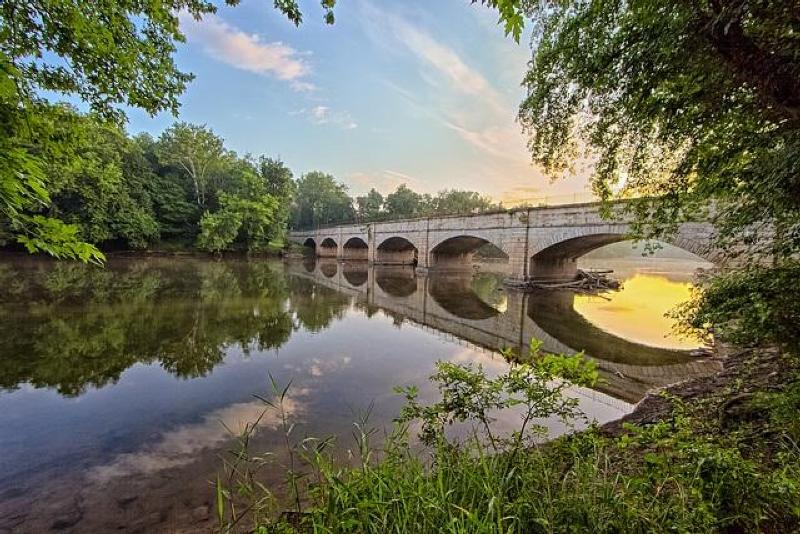
Eleven aqueducts stand along the C&O Canal – some of the most impressive of the canal structures that stand today. Aqueducts transported the canal over streams and tributaries. Several have been rebuilt, including the Conococheague Aqueduct in Williamsport, which is watered and is one of the only places in the country where you can ride a boat over an aqueduct. The eleven aqueducts are all different – the stone they were constructed with varies, including red sandstone, grey limestone, white granite, white and pink quartzite. Some have fallen apart and exist only as ruins, while others have been lovingly restored by the National Park Service to their former glory. All stand testament to the engineering ingenuity and devoted labor that went into their construction and the important role they played in the growth of our country.
East: DC to Brunswick
Mile Marker 1.0 Alexandria Aqueduct
An earlier attempt to relieve the congestion of canal boats unloading cargo in Georgetown, the Potomac Aqueduct allowed canal boats to cross over the Potomac River, connect with the Alexandria Canal, and deliver goods to the wharves at Alexandria, Virginia. This structure was built between 1833 and 1843. Only two of the aqueduct’s abutments and one pier near the Virginia shore remain today. Because this aqueduct was constructed by the City of Alexandria, it is not counted in the Park’s eleven.
Mile Marker 22.7 Seneca Aqueduct
Seneca Aqueduct and Lock 24 are combined into a single structure here, the only place along the canal that this was necessary. This is one of 11 aqueducts that carried the canal over major tributaries of the Potomac.
Mile Marker 42.2 Monocacy Aqueduct
The Monocacy Aqueduct is the largest of the canal’s 11 stone aqueducts. It is often considered one of the two finest features of the C&O Canal. It was built from 1829-1833.
Mile Marker 51.5 Catoctin Aqueduct
The Catoctin Aqueduct is listed on the National Register of Historic Places. It was built with two semi-circle arches on either side of an elliptical arch. The elliptical arch was not structurally strong and began to sag, leading to structural failure. In 1973 two arches collapsed leaving only a remnant of the eastern arch standing. The Park Service buried the original stones to help preserve them in case the aqueduct was ever restored, which began in 2007. The restored aqueduct was dedicated and re-opened in 2011.
- Alexandria Aqueduct
- Seneca Aqueduct Credit: Doug Zveare
- Catoctin Aqueduct Credit: CHOH NPS
- Alexandria Aqueduct after the Civil War. Credit: CHOH NPS
- Monocacy Aqueduct Credit: Steve Dean
- Catoctin Creek Aqueduct, 1973
Central: Brunswick to Hancock
Mile Marker 69.4 Antietam Aqueduct
The Antietam Aqueduct is the fourth of 11 stone aqueducts. The 140-foot structure is built of limestone from a nearby quarry and has three elliptical arches. It’s located near Antietam Battlefield but actually sustained extensive damage by the Confederates during General Jubal Early’s invasion of Maryland in 1864.
Mile Marker 99.6 Conococheague Aqueduct
Completed in 1834, the Conococheague Aqueduct was built of limestone from nearby quarries. The aqueduct has three equal arch spans. Both armies launched raids against the aqueduct during the Civil War. Years later, the berm wall collapsed early on the morning of April 20, 1920. The boat traveling across the aqueduct fell into the Conococheague Creek and remained there until the 1936 flood carried it down the Potomac. A full restoration of the aqueduct was completed in 2019. Canal launch boat rides across the re-watered aqueduct are offered seasonally.
Mile Marker 116.1 Licking Creek Aqueduct
The 90-foot, single-span aqueduct was described by the C&O Canal Company in 1839 as “one of the longest, if not the longest aqueduct arch which has been constructed in the United States.” Constructed between 1836 and 1838, the structure is largely built of limestone and cement transported from nearby Hook’s mill, just across the river from Hancock. The aqueduct was first used in 1839 when the canal was watered from Dam no. 6 down to Dam no. 5. This was the same year canal operations began in the town of Hancock.
Mile Marker 123.0 Tonoloway Aqueduct
Constructed between 1835 and 1839 of limestone extracted upstream on Tonoloway Creek, Tonoloway Aqueduct carried canal boats across Tonoloway Creek, a 31-mile tributary of the Potomac River. Cement for the aqueduct came from Captain Hook’s mill but during a water shortage in the summer of 1837, cement was imported from Boteler’s Mill and Baltimore.
- Antietam Aqueduct, ca. 1960
- Antietam Aqueduct
- Conococheague Aqueduct 1920 Credit: CHOH NPS
- Licking Creek Aqueduct
- Tonoloway Aqueduct Credit: Doug Zveare
- Conococheague Aqueduct Credit: MJ Clingan
West: Hancock to Cumberland
Mile Marker 136.6 Sideling Hill Creek Aqueduct
The Sideling Hill Creek Aqueduct was built between 1837 and 1840, primarily using Tonoloway Limestone from the quarry at the mouth of the Cacapon River, as well as Pocono sandstone rubble from Sideling Hill. The aqueduct has a single arch with a 70-foot span. The creek marks the boundary between Washington and Allegany Counties.
Mile Marker 140.9 Fifteenmile Creek Aqueduct
The Fifteen Mile Creek Aqueduct is a small, single-arch aqueduct. Built between 1838 and 1850, it is in excellent condition for a century and a half old structure. It was constructed with hard flint stone quarried at Sideling Hill on the West Virginia side of the river. In 1842, during construction, the Canal Company ran out of funds and work was suspended for a time, but finally, work was completed and the aqueduct began service in 1850.
Mile Marker 162.4 Town Creek Aqueduct
Town Creek Aqueduct is a single-span aqueduct. Construction began in 1837 and was abandoned in 1838 when the contractor quit during the Canal Company’s financial crisis. It was completed during the final phase of C&O Canal construction (1848-1850) by Michael Byrne. It is the tenth of 11 aqueducts on the Canal and, like many of the other 11, is missing its upstream wall.
Mile Marker 180.7 Evitts Creek Aqueduct
The Evitts Creek Aqueduct is the last of the 11 aqueducts on the Canal, and is made of “Fossilferous Tonoloway Limestone” quarried upstream and shipped to the aqueduct via a 1.5 mile railroad. Work began in 1839 and was completed in 1841 when the C&O Canal Company ran out of funds, with final touches and service beginning in 1850.
- Evitts Creek Credit: Paul Graunke
- Town Creek Aqueduct
- Fifteenmile Creek Aqueduct Credit: PAT GPS Rangers
- Sideling Hill Creek Aqueduct Credit: Alan Taylor
Written By: Charissa Hipp


